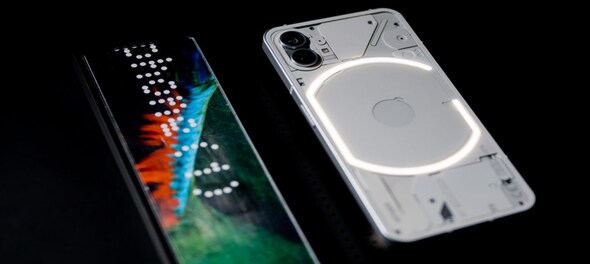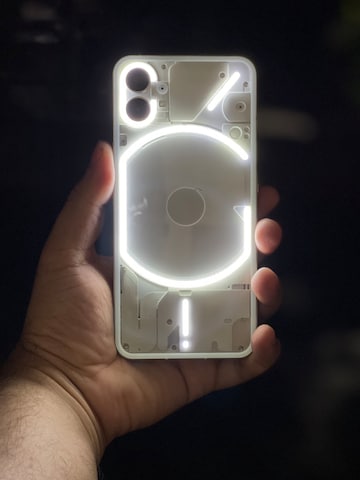
So much has been said and written about the Nothing phone (1) in the past few weeks that it is difficult to say or write anything new. That said, I have used the Nothing phone (1) for just over 10 days and I have thoughts.
The phone (1) is Nothing’s second stab at the consumer electronics market — the first being the Truly Wireless Stereo ear (1). And… I’m impressed.
The Nothing phone (1) is available in two colours, white and black, and comes with different combinations of RAM/storage — 8/128, 8/256, 12/256. The review unit I received was a white phone with 12 GB of RAM and 256 GB of storage.
Firstly, the phone feels really solid in the hand — it is well-built, there is no flex anywhere and yet, despite its physical footprint (it is as big as the iPhone 13 Pro Max), it feels light and is comfortable to use one-handed. That it looks damn good, feels premium, is an added bonus for a phone that plays in the mid-range tier — the screen and the back are protected by Gorilla Glass 5, while the frame is made of aluminium. The glass makes it grippy, and in my 10 days with the phone, showed few smudges.
The screen, despite being a Full HD+ display, is a pleasure to look at — there have actually been times when I just stared at the screen for minutes on end. It’s an OLED display and delivers punchy colours, deep blacks and renders sharp videos. But the real champion here is the 120 Hz display, which makes the user experience snappy and makes the phone feel very responsive.
The phone (1) also boasts stereo speakers, wireless charging, reverse charging that allows you to use the phone itself as a wireless charger.
Let’s take a more detailed look at the phone (1).
Screen
As mentioned earlier, the Nothing phone (1) comes with an OLED display with uniform bezels all around, which is unusual for a phone in this price range — most other phones have a 'chin' at the bottom. During the keynote while unveiling the phone (1), Carl Pei — the founder of Nothing — explained that they used a flexible OLED panel that allowed them to fold it at the bottom to be able to give the phone uniform bezels.
The display itself is great to look at — the colours are vibrant, videos look great and content is rendered well. It is not an LTPO display, which would have allowed the phone’s screen refresh rate to drop as low as 1 Hz, but the phone (1) does have variable refresh rate — depending on the content, the device drops the refresh rate to 60 Hz and ramps it up to 120 Hz if you’re scrolling. The result? A buttery smooth experience.
That is not to say my experience was flawless. The Nothing phone (1), after all, is a first-generation device from a company that is just about two years old and there were some software hiccups here and there, but none that detracted from my overall experience.
Processor
Nothing has said it worked with Qualcomm for a customised Snapdragon 778G+ SoC (system-on-a-chip), and during my use, I didn’t feel like I needed the extra horsepower of a flagship chipset. The processor was more than up to the task, be it gaming, browsing, or video streaming.
There was the occasional lag or instances of apps freezing, but nothing (my first pun) a software update cannot fix. Also, Nothing had to cut corners to ensure the phone (1) came at an affordable price, but I doubt many regular users will need any more power than the 778G+ offers. Thanks to software optimisation, the phone hasn’t once heated up, not in the slightest.
Battery life
This is one area where I felt let down. The 4,500 mAh battery in the Nothing phone (1) is strictly… just okay. Don’t get me wrong. I’m a heavy user and I would end my day with about 20% left in the tank, but I will admit I expected a little more out of the phone. That said, I’m someone who always charges the phone at night, every day, so this wasn’t really an inconvenience. However, if you expect more than 24 hours of battery life — with about 5-6 hours of screen time, then you might feel disappointed.
Cameras
The Nothing phone (1) packs two 50 megapixel cameras at the back and a 16 MP selfie camera. The camera features are bare bones, but I’ll eat my hat if you use more than the features provided for longer than your first month of owning the phone (1). In my experience, fun features remain a novelty for only so long before you fall back on the basics of smartphone photography — taking still pictures, and shooting videos.
In this department, Nothing phone (1) offers a decent experience. The photos shot with the main sensor have good detail without over-sharpening, while the 2x zoom and the 0.6x ultrawide modes are fine, but not great. Then again, this is about the experience one would expect in a phone that costs around Rs 32,000 for the base variant.
That said, the photos this phone takes aren’t bad, but if you’re expecting flagship-level photos from the debut smartphone from a startup, then you’re better off buying a flagship phone that costs twice as much, at the very least. Take a look at these photos shot on the Nothing phone (1).
 Shot using the 0.6x ultrawide lens. (Image: Vijay Anand)
Shot using the 0.6x ultrawide lens. (Image: Vijay Anand) A view of the same building, using the primary lens. (Image: Vijay Anand)
A view of the same building, using the primary lens. (Image: Vijay Anand) Shot in the ultrawide mode. (Image: Vijay Anand)
Shot in the ultrawide mode. (Image: Vijay Anand) This was shot using the 2x optical zoom lens. (Image: Vijay Anand)
This was shot using the 2x optical zoom lens. (Image: Vijay Anand) The same building, shot on the ultrawide lens. (Image: Vijay Anand)
The same building, shot on the ultrawide lens. (Image: Vijay Anand) (Image: Vijay Anand)
(Image: Vijay Anand) The macro mode. (Image: Vijay Anand)
The macro mode. (Image: Vijay Anand) This was the only time I could get my cat to sit still. (Image: Vijay Anand)
This was the only time I could get my cat to sit still. (Image: Vijay Anand)Operating System
Nothing phone (1) offers a near stock Android experience with its Nothing OS skin, and this was easily my favourite feature. The software is superbly optimised and I had fun playing with the phone. In this, at least, Nothing lived up to its motto, 'Make tech fun again.'
Nothing promises three years of OS updates, beginning with Android 13, expected to be released later this year, and four years of bi-monthly security patches. Nothing tells me that the updates will come on time as the company has partnered with Google. If this stands, then expect to receive OS updates at the same time as Google’s own Pixel series.
The phone (1) also features a face unlock feature and a sonic fingerprint scanner under the screen, and both have been very responsive and fast — with the occasional niggle — in the 10 days I got to spend with the phone.
Speakers
The phone (1) boasts of stereo speakers — with the earpiece doubling as the second speaker — and the audio is loud, for certain, though it lacks the bass-ey punch that other phones, even those in this price bracket, offer.
Glyph Interface
Easily the coolest feature of the Nothing phone (1), the Glyph Interface is the one feature that helps the smartphone standout from the back. The company has used 900 LEDs in lighting strips on the back, and these can be customised according to the ringtone or notification alert selected. You can assign different ringtones/notifications to each contact and the LEDs will obediently light up.
 The Glyph Interface. (Image: Vijay Anand)
The Glyph Interface. (Image: Vijay Anand)However, this feels like somewhat of a gimmick — how many people place their phones face down on a desk? Certainly not me. Perhaps future iterations of the phone (1) will refine this feature, but the lack of customisation by the user feels like a wasted opportunity — if I could have configured the lights as I wanted, then maybe I’d have an incentive to look at the lights flashing rather than the caller ID. The only time I see the Glyph Interface being truly useful is if you use that as a fill light while shooting a subject in low-light conditions.
That said, the Glyph Interface is undeniably cool.
Ecosystem
Here’s where Nothing seems to have taken a leaf out of Apple’s playbook. And it’s not a bad way to start. Nothing has made it ridiculously easy to pair Bluetooth accessories, such as TWS earbuds, especially if they are the ear (1). The first time you pair the ear (1) to the phone, a very iPhone-like pop-up appears at the bottom of the screen to help you pair the earbuds to the phone and once done, you can access the setting via the quick settings menu — accessed by swiping down from the top.
This is — at least to me — an easter egg: Nothing clearly has something up its sleeve, given how much the marketing team stresses on the company goal of building an "open” ecosystem.
I look forward to seeing what Nothing comes out with next — a smartwatch, smart speakers, laptops, or other wearables?
We know nothing, but Nothing certainly knows something.
Overall, I’d rate the phone an 8/10 — solid for a first smartphone from a company still in its nascency — and wouldn’t hesitate in recommending it to anyone who wants a stock Android experience in a premium-looking smartphone.
(Edited by : Shoma Bhattacharjee)
Note To Readers
Nothing sent me a review unit of the phone (1) and the device has since been returned to the company. Nothing had no inputs or oversight over this review.
Check out our in-depth Market Coverage, Business News & get real-time Stock Market Updates on CNBC-TV18. Also, Watch our channels CNBC-TV18, CNBC Awaaz and CNBC Bajar Live on-the-go!


Lok Sabha elections 2024: BJP's bid for breakthrough in Kerala is an uphill battle, say experts
Apr 23, 2024 9:53 PM
2024 Lok Sabha Elections | PM's Rajasthan speech — has it anything to do with the post-poll mood of the first phase
Apr 23, 2024 3:45 PM
It's KGF 2024 and here's a look at the key characters in Karnataka
Apr 23, 2024 3:17 PM
JP Morgan: Nifty may test 25,000 if BJP wins in 2024 Lok Sabha elections
Apr 23, 2024 2:23 PM

